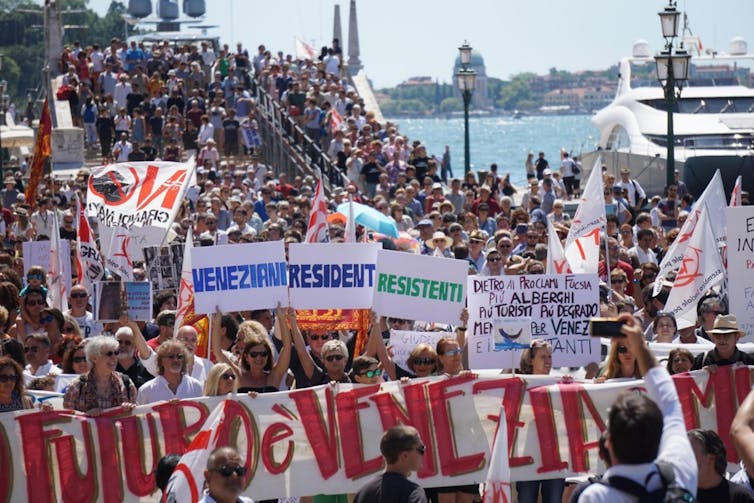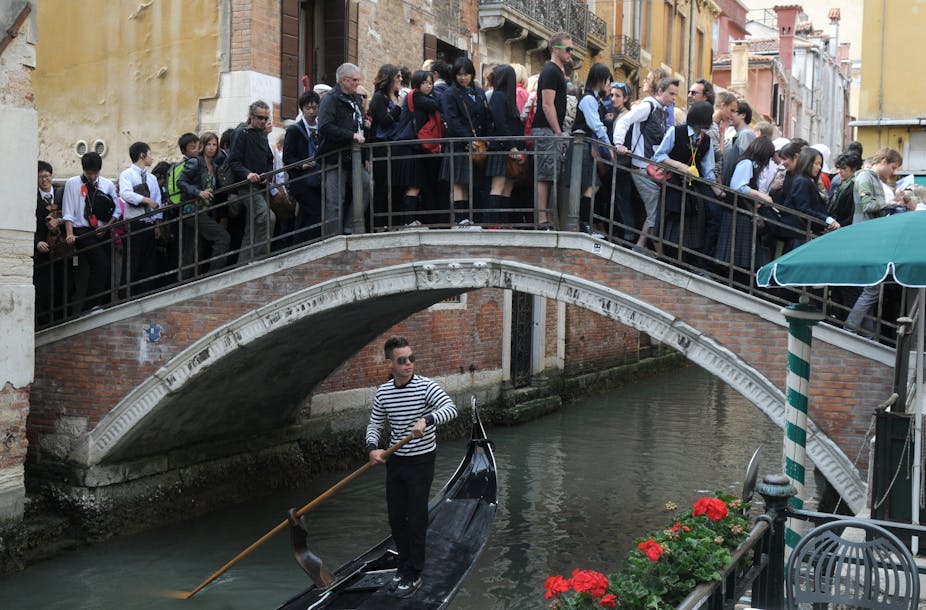Venice’s history, art and architecture attract an estimated 20 million visitors every year. The city, a Unesco World Heritage site, is often crammed with tourists in search of special memories.
But for the people who actually live there, this level of tourism has become unsustainable. So from 2024, day-trippers will be charged a €5 (£4.31) fee as part of an attempt to better manage the flow of visitors.
The city’s mayor has described the charge – which will be implemented on 30 particularly busy days in the spring and summer – as an attempt to “protect the city from mass tourism”. It comes after cruise ships were banned from entering the fragile Venice lagoon in 2021.
Both policies are designed to respond to the particular problem facing Venice, which is that around 80% of its tourists come just for the day. Research has shown that such a high proportion of day-trippers – who tend to spend little – pushes a tourist destination towards decline.
So from next year, all travellers to Venice will have to register their visit in advance and obtain a QR code online. Day trippers will then have to pay the fee; visitors staying overnight will not.
Other exemptions include children under 14, as well as people who travel to the city for work and study, or to visit family members. To enforce the policy, the municipal police and authorised inspectors will carry out random checks. Anyone without the proper QR code will face a fine of up to €300 (£261).
But some have expressed doubts about whether the €5 fee – the price of a coffee or an ice cream – will be enough to dissuade tourists from travelling to this iconic ancient city. One city politician commented that the charge means Venice has become “a theme park, a Disneyland,” where “you get in by paying an entrance fee.”
Certainly the charge is a lot less than Bhutan’s (recently reduced) “sustainable development fee” of US$100 (£82) per night, which applies to all tourists, and was introduced to encourage “high value, low impact” tourism. Research also indicates that strategies aiming at persuading tourists to come at less crowded times do not reduce numbers at peak periods, but actually end up increasing overall demand.
‘Veniceland’
But Venice has to try something. For researchers, Venice is the embodiment of overtourism, and residents clearly suffer from the consequences – living with the congestion, environmental damage and affects on their lifestyle and culture that 20 million visitors can cause.
This can then lead to a negative response, known as “tourismphobia”.Another term, “Venice Syndrome” has been used to describe the decline of the city’s permanent population, as citizens feel forced to leave.
Venice’s population is around 50,000 and has been consistently falling, from a peak of 175,000. If the population falls below 40,000, there is concern that Venice will cease to be a viable living city.
Those who remain have often expressed their discontent. Well publicised protests have included the “Funeral of Venice” in 2009, a mock funeral to mourn the sharp drop in population, and “Welcome to Veniceland” in 2010, which claimed that Venice was becoming more of a theme park.

And while “tourist taxes” remain popular strategies to address overtourism, their effectiveness remains debatable. Instead, research suggests that a combination of specific economic measures (like fees and variable pricing) and non-economic policies (such as educating visitors) is the best option.
That combination needs to be specially designed for each destination. There can be no one-size-fits-all solution. A report by the World Tourism Organisation on overtourism identifies 11 different strategies and 68 measures to manage visitors’ growth in urban destinations.

Barcelona, often seen as a city which has done well in handling mass tourism, has successfully used a well targeted approach. This has included harnessing new technology to develop a data driven management system to control visitor flows and overcrowding. It also deliberately engaged with the public when deciding on policies, and came up with specific strategies like limiting the number of new souvenir shops.
But it did not resort to charging an entrance fee. Venice will be the first city in the world to do so – and other locations struggling with mass tourism will be keeping a close eye on whether such a bold move turns out to be a success.

